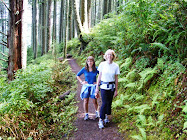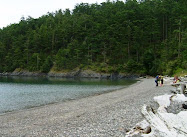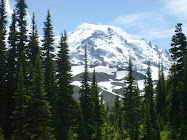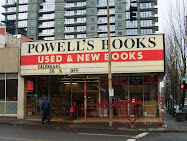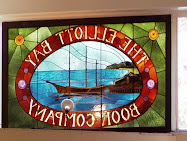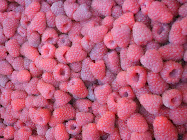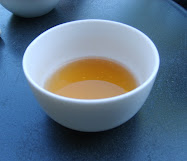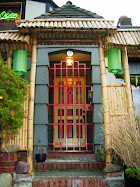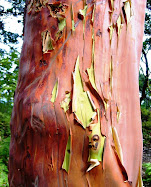
“Here you go, honey!” says our friendly waitress as she places my burger in front of me. Our group of 10 tromps into
Lana’s Hangar Cafe for lunch and, undaunted, she gets every order right. This is service with an easygoing smile. We’re in
Hoquiam and
Aberdeen today for a work-related outing, but that doesn’t mean we can’t have some fun and a good lunch.
Lana’s is located next to
Bowerman Airport, a few miles west from downtown Hoquiam on the shore of
Grays Harbor. With kitschy Betty Boop artwork and the front grill of an old car mounted on the wall behind the counter, it has a retro diner vibe. We’re tucked into a row of booths with a view of the water.

My cheeseburger hits the spot. The sesame seed bun is fresh and soft, layered with all the right stuff (fresh lettuce, tomato, onion, pickle) and a classic Thousand Island-type sauce, which I supplement with catsup and mustard. Nothing fancy, just a good All-American burger. I didn’t order fries, but I snagged a few from my co-worker Dennis. I’m impressed. Not too greasy, slightly crispy on the outside and soft on the inside—I can actually taste the potato. Dennis is so thrilled with his creamy vanilla milkshake that he asks the waitress, “Do you throw in a special secret ingredient that makes it so good?”
We lucked out with a fairly dry November day in an area that gets twice as much rain per year as Seattle and Portland. “Today is the first day it hasn’t poured in eight days,” a local man tells me as I wait in line to pay my bill after lunch. We all roll out of the cafe full and satisfied.

If you want to get a sense of old Pacific Northwest logging towns that ruled the region 100 years ago, head to Aberdeen/Hoquiam on Grays Harbor. The soggy lowland hills of southwest Washington comprise one of the most productive timber-growing regions in the world, and Grays Harbor towns still support some logging. The legendary old growth trees were mostly cut over 75 years ago. A few timber and pulp mills survive, although at a much reduced scale since the industry peak from the 1920s through the 1950s.
As late as the 1970s, timber was the economic backbone of many small Northwest towns. Aberdeen/Hoquiam has been economically depressed since then, decades before our current recession. With all that rain, gray skies, and unemployment, it’s easy to imagine how the area spawned the raw grunge music of Nirvana’s
Kurt Cobain and Krist Novoselic, who both grew up here.

Most travelers just drive through Aberdeen/Hoquiam on their way to Ocean Shores, Westport, Moclips, or other coastal vacation towns. But I say Aberdeen and Hoquiam are worth a visit. Besides experiencing the local culture and the good burgers and shakes at Lana’s, take your binoculars and head to the
Grays Harbor National Wildlife Refuge near the airport.

This birding destination is one of four major migratory stops in North America and hosts one of the largest concentrations of shorebirds on the West Coast in the spring and fall. You might even spot a threatened species on your way there—
logging truck.
When You GoAberdeen is 83 miles from Seattle and 143 miles from Portland. From Seattle, take the US 101 exit off I-5 in Olympia. From Portland, cut off a few miles (albeit on a slower road) by taking the State Route 12 junction off I-5 near Grand Mound. To be fair, there are other good burgers to be had in the area. Sources tell me that
Clarks Restaurant between Cosmopolis and Raymond south of Aberdeen on US 101 is worth a stop, especially for their milkshakes topped with a scoop of homemade vanilla ice cream.

 Once I got started, my mind ran like crazy. I’m grateful for flannel sheets, the raspberries and blueberries that I pick with my niece every summer, the scent of daphne in the spring, shooting stars, a good laugh, good books, good films, good friends, family, pumpkin spice cupcakes, avalanche lilies, the spiraling song of a Swainson’s thrush, persimmons, being raised and living in such a beautiful region...I could go on and on. So could you, no doubt.
Once I got started, my mind ran like crazy. I’m grateful for flannel sheets, the raspberries and blueberries that I pick with my niece every summer, the scent of daphne in the spring, shooting stars, a good laugh, good books, good films, good friends, family, pumpkin spice cupcakes, avalanche lilies, the spiraling song of a Swainson’s thrush, persimmons, being raised and living in such a beautiful region...I could go on and on. So could you, no doubt. 



















